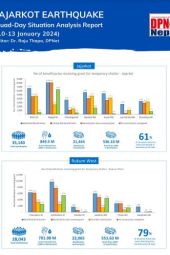Jajarkot Earthquake : Quad-Day Situation Report (10-13 Jan 2024)
Summary
This report highlights that over two months since the Jajarkot earthquake, more than 62% families continue to live in makeshift shelter including tarpaulin due to the slow progress in constructing temporary shelters. The lengthy wait for government assistance and funding delays have exacerbated the hardships faced by the affected families, especially in the harsh winter conditions. The report also notes that in Jajarkot alone, a significant number of families are still awaiting the first installment for temporary shelter construction, with only a fraction of the required shelters completed so far. Further, the report brings attention to the slow disbursement of funds earmarked for shelter construction, which has hindered the building of adequate temporary housing. This situation has left many vulnerable groups, including the chronically ill, pregnant women, and children, in dire circumstances. Local government inefficiencies are cited as a primary factor contributing to the delay in managing the earthquake-affected population.
The report also covers the state of Jajarkot's heritage sites, which remain in ruins, posing additional challenges to reconstruction efforts. The earthquake's impact on government and community buildings, as well as police posts in the Karnali Province, is significant, with many structures still awaiting repair and reconstruction. In terms of health initiatives, the report highlights the successful vaccination campaign against measles/rubella and typhoid in the earthquake-affected districts, reaching a high percentage of the targeted population. This proactive step was taken to mitigate the risk of potential disease outbreaks in the aftermath of the earthquake. The recent seismic activities in Western Nepal, including tremors in Bajhang, highlights the urgent need for earthquake preparedness and resilience in the region. This series of earthquakes emphasizes the long seismic gap and constant geological threat and the necessity for comprehensive preparation.
Additionally, the report highlights the issue of forest encroachment in Jajarkot, particularly in the wake of the earthquake. Concerned authorities have taken a stand against unauthorized shelter construction and tree cutting in community forests, emphasizing the need for sustainable practices and legal compliance. The personal story of Juna Pariyar, a resident struggling with the loss of her sister and her own injuries from the earthquake, is also included, underscoring the profound personal impacts of the disaster.
Finally, the report concludes with a call to action for agencies to submit their data for the Jajarkot Earthquake Relief effort. This final reminder highlights the importance of documenting and recognizing the contributions made by various agencies in the relief efforts.
Categories:
DPNet Publication
Sub-Categories:
Situation Analysis Report
Published Year:
2024
